

 |
|
|
An Online Newsletter Showcasing Our Programs for the Month of June 2025! |
|
|
As June begins, we invite you to catch the final days of our current exhibition Path to the Perfect Cup: Coffee Culture in Japan. If you haven’t had the chance to visit yet, we encourage you to stop by and explore the rich traditions and innovations behind Japan’s coffee culture by Saturday, June 7th. Our next exhibition will start on Wednesday, June 18th featuring Ibuki Kuramochi. We are also excited to host three events in the first three days of the month starting with a special screening of The Wild West followed by a panel discussion with the film's producer and three stars of the film including two sumo wrestlers. This is followed by a meditation with art event that brings together mindfulness and a curated coffee tasting experience. The last event shifts from taste to scent and space with a lecture exploring these themes during the times depicted in the Tale of Genji. During the month, we will be engaging with the public every Wednesday with a new cultural event. Starting with our lecture series - 5 Dimensions of Japanese Architecture Part 5 Suki: Microcosm of Tastes, followed by Japan and Kami Part 3: Shinto and Japanese Life as seen at Meiji Jingu Shinto, the previously mentioned Solo Exhibition, and a special Noh Mask Carving Lecture and Demonstration at Lamanda Park Library, followed by a second event at JFLA. Finally, our headquarters has released eight new cultural videos as part of the Online Japanese Filem Festival, each one focusing on a unique perspective from four different regions across Japan. As always, we are working hard to bring you a dynamic calendar of programs, and we hope you will join us this month to explore the many layers of Japanese culture. One quick note: We've noticed that Google Maps has been incorrectly marking our location. Please make sure your search directs you to Mid-Wilshire, between Masselin and S Curson Ave. The entrance is located on Courtyard Place. You can find a map and street view of our building below for easy reference.
|
|
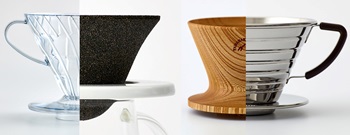 |
DESIGN EXHIBITION Coffee culture is currently in a “third wave” that emphasizes an artisanal approach to the beverage by considering the source of the coffee bean, its level of roasting, and the method of brewing. There are various ways to brew coffee, each of which involves a particular tool and technique. Perhaps the most popular brewing tool is the dripper, and the best-known examples are produced by companies in Japan. But why, if Japan is traditionally associated with tea, is this the case? It can be argued that Japan’s tea culture is the foundation upon which Japanese coffee culture flourished to its current form. Music and entertainment from the West had been integrated into Japanese popular culture alongside coffee, resulting in social establishments such as the coffee-focused kissaten. This exhibition, organized in collaboration with Kurasu, explores the effects that coffee has had on Japan and, simultaneously, the extraordinary contributions that Japan has made to the global coffee community. |
|
|
MOVIE & PANEL The Sumo Wrestlers are coming! This will be the world premiere of the film "The Wide West", inspired by the true, historic meeting between Japan's first sumo delegation and President Theodore Roosevelt in Washington D.C. in 1907. The screening will be held at JFLA, with the film's three BIG stars in attendance: three-time Mr. Universe Alexander Nevsky and Sumo Champions Hiroki Sumi and Ichi (former Ichinojo). Following the film, there will be a discussion and Q&A with the producers and the stars. There will also be a photo session with the 3 stars, so be sure to take advantage of this rare opportunity to take a photo with the 3-time Mr. Universe and the 2 Sumo Champions! Also expected are director Joe Cornet, as well as co-stars Tatiana Neva, Nick Baillie, and Kaz Kobayashi. |
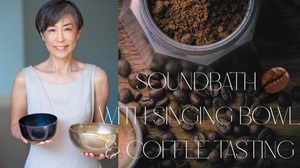 |
WELLNESS Refresh and recharge with a sound bath! The singing bowl used for this program harmoniously combines the healing qualities of both the Tibetan singing bowl and the Japanese traditional singing bowl. Choose a space near your favorite artwork in the design exhibition "PATH TO THE PERFECT CUP: Coffee Culture in Japan", relax and feel your stress dissipate into thin air as the sounds of the singing bowl lead you into a meditative state. We will put bowls of coffee in the room to fill it with the smell and provide samples of freshly brewed coffee to attendees! There is no admission fee, but a reservation is required. We will provide a chair and small cushion for you to sit on, but you are welcome to bring your own cushion or yoga mat. |
|
|
JFLA LECTURE In classical Japanese literature, the term oikaze (literally "tail wind") refers to the faint scent one encounters when passing by, or the fragrance wafting from a room. It captures the phenomenon of an aroma being carried by the flow of air to one’s sense of smell. Though once common, this term has fallen into disuse in modern Japan. Drawing inspiration from this term, this lecture focuses on Chapter 25, titled Fireflies from the Tale of Genji. This chapter takes place in the fifth month of the lunar calendar—roughly aligning with the timing of this event—which coincides with Tango no Sekku (the seasonal festival of boys), a time of year rich in fragrance. In the Summer Quarter where the story unfolds, fragrant tachibana (citrus blossoms) bloom, shōbu (calamus) and yomogi (mugwort) are hung under the eaves, and kusudama (decorative herbal balls) are displayed to ward off evil. Fireflies begin to appear in the humid air of the early summer rains (samidare). It is in this sensuous and visually poetic atmosphere that Prince Hotaru Hyōbu-kyō falls in love with Princess Tamakazura. In this lecture, participants are invited to experience this beautiful chapter in three dimensions—through the sense of smell. |
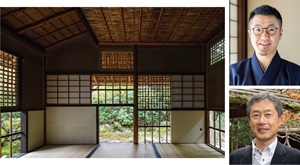 |
LECTURE SERIES To discuss Japanese architecture, this talk series is organized around five concepts unique to Japan: MA, KANE, HAI/KYO, IN/EI, and SUKI. Renowned Japanese architects and scholars will speak at each symposium about their ideas on architecture and the works they have produced. This series offers a unique opportunity to deepen your understanding of Japanese architecture and its cultural concepts by featuring their insights, enriching your perspective on this distinctive architectural heritage through the lens of contemporary practice. The fifth session will discuss the concept of「数寄」 (SUKI). SUKI originally signified a love for poetry in the Heian period, but evolved to primarily denote the refined aesthetic and cultural appreciation associated with the tea ceremony, reflecting a nuanced relationship between art, architecture, and the appreciation of beauty. |
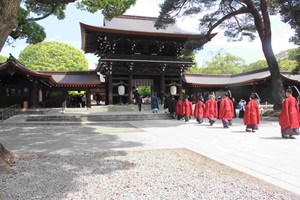 |
ONLINE LECTURE SERIES In this lecture, Moriyasu Ito, who has served as a Shinto priest at Meiji Shrine, an institution widely known to Americans, will introduce Meiji Shrine while discussing what a shrine is, what kami is within Shinto, the relationship between Japanese life and Shinto, and Shinto from an international perspective. He will contextualize this information based on his global experiences. This is the third lecture in a four-part series that will explore the various relationships that exist between Japanese culture, Shinto, and its deities. |
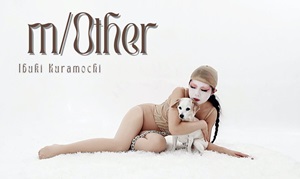 |
EXHIBITION Opening Reception m/Other is a meditation on kinship, the maternal principle, and Otherness—not as fixed categories, but as shifting, unstable forces. Moving between the human and non-human, organic and synthetic, Ibuki Kuramochi reimagines the maternal as a site of both intimacy and alienation, power and dissolution. Inspired by Donna Haraway’s philosophy of companion species, this exhibition draws on Japanese custom to ask: What does it mean to mother—not a child, but an idea, a creature, a memory, a wound? Here, the uterus is not merely biological, but a conceptual matrix—a haunted space of inheritance, trauma, and transformation. The Japanese tradition of preserving the umbilical cord becomes a symbol of kinship that extends beyond bloodlines, into interspecies care and nonlinear histories. Kuramochi’s practice is grounded in Butoh—a form born from postwar collapse—whose physical language functions as a code for navigating grief, mutation, and metamorphosis. Through video, performance, and installation, she invokes the body as a porous vessel entangled with memory, ancestry, and technology. In m/Other, the figure of the mother flickers—ghost, cyborg, companion, absence. Among them is the artist’s aging dog, whose presence, tender and temporary, informs the exhibition’s meditation on care. The “/” signals rupture and multiplicity, opening space for fragmented lineages and speculative kinships. m/Other invites us to mourn, remember, and reimagine what care might mean now—across generations, species, and time. |
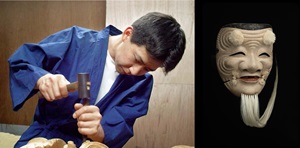 |
TRAVELLING LECTURE Noh theater is a traditional Japanese performing art that is characterised by stylised movements and a distinct form of singing. While the performers wear carefully-carved masks to depict certain character types, they emote by adjusting the angle from which the audience can see their mask. Hideta Kitazawa will introduce the fascinating world of Noh masks, demonstrating the techniques used to make them while offering a rare chance to take a closer look at these wooden works of art. He will also present some of his more recent creations inspired by contemporary characters. generations, species, and time. |
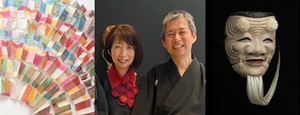 |
JFLA LECTURE Noh theater is a traditional Japanese performing art that is characterized by stylized movements and a distinct form of singing. While the performers wear carefully-carved masks to depict certain character types, they emote by adjusting the angle from which the audience can see their mask. The clothing, too, impacts how the audience perceives specific characters as the patterning in Noh costumes convey identity and meaning. Hideta Kitazawa will introduce the world of Noh masks, including the types of mask and the characters they are intended to portray. Then, through a live demonstration, he will show the techniques used by traditional woodworking artisans to strip away raw material and reveal the mask that is at the heart of the wood. He will also present some of his more recent creations inspired by contemporary characters. Miyoko Yoshiya will first explore the traditional patterns used in Noh costumes. Then, she will talk about her own journey as an artist and her unique approach to textiles that draws on a sensitivity from being born and raised in Japan. The ultra-thin cloth felts that Miyoko produces, made from domestic Kawamata silk, can be compared to Japanese paper in that they have a gentle and warm texture. |
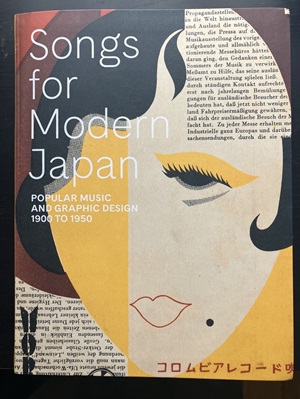 |
JFLA LECTURE This talk introduces the topic of Japanese sheet music cover design from 1920-1950 as the nexus of visual art, film, and popular song. It posits the humble, disposable and seemingly obscure music sheet as perhaps the most sensitive lens for capturing modern popular arts in Japan during the tumultuous period before, during and just after WWII. The lecture includes snippets of Japanese music and film. |
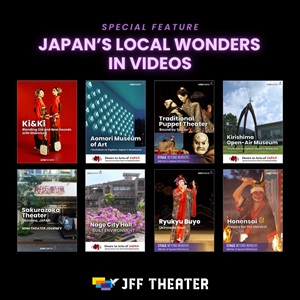 |
ON DEMAND As mentioned last month, JFF is proud to present eight cultural videos showcasing the beauty and charm of four selected regions across Japan! Now Revealing the Eight Cultural Videos: Aomori
Kagoshima
Okinawa
All content is available for free with multilingual subtitles on JFF Theater. |
 |
JAPANESE FILM SCREENING Shohei Sugiyama (Koji Yakusho) seems to have it all – a high-paying job as an accountant, a beautiful home, a caring wife and a doting daughter he loves dearly. However, he feels something is missing in his life. One day while commuting on the train he spots a beautiful woman staring wistfully out a window and eventually decides to find her. His search leads him head-first into the world of competitive ballroom dancing. |
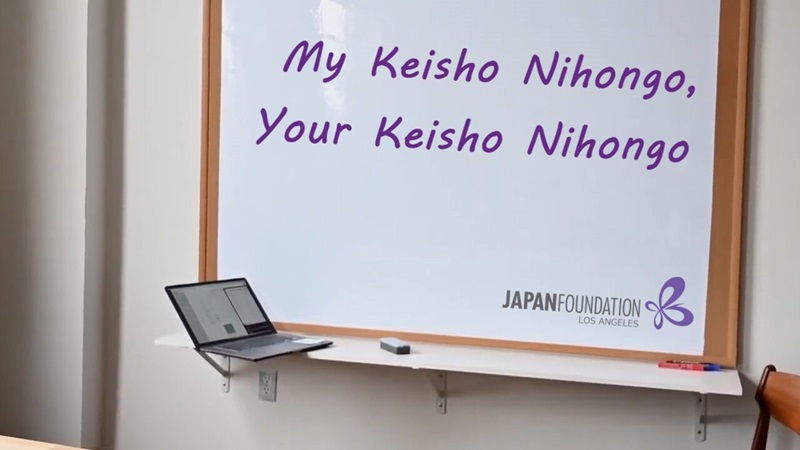 |
|
|
New Video Interview Series: My Keisho Nihongo, Your Keisho Nihongo Being a Keisho Nihongo/Japanese-as-a-Heritage-Language (JHL) learner, as opposed to a Japanese-as-a-Foreign Language (JFL) learner, can carry with it a set of unique challenges when there is a lack of local access to specialized education and community. Bicultural identity, especially in countries rich in diversity like the U.S., can factor into these learners' language acquisition and can be difficult for them to navigate. In this interview series, we talk with Keisho Nihongo learners about the personal challenges they faced and what helped them overcome those challenges. We hope that the advice, perspectives, and unique stories offered in these interviews will help and motivate other Keisho Nihongo learners throughout the U.S. William Kimmel: https://youtu.be/cQ-hhFGQUrk Luke Palermo: https://youtu.be/Y3EopxyplYs |
|
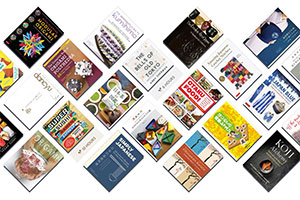 |
General Invitation to Join JF USA Digital Library We recently renewed and added many new books in coordination with our New York and Toronto offices for our patrons in the US and Canada. There have also been an uptick in the number of applicants as well, which shows that this is a very popular service. We have also updated the application survey and the confirmation emails are still going out once a week on Wednesdays by 6:30PM pacific time. If you register and do not receive a welcome email from us within a Wednesday of registering, please contact us so we can help you out. |
 |
|
|
2025-2026 Japanese Language Grants Now Available! Grant for Nationwide/Statewide/Region-wide Events for Learners Grant for Nationwide/Statewide/Region-wide Projects for Teachers Grants for Individual Japanese Language Programs Advocacy Support Letter Click Here to contact us and select Anything Related to Japanese Education. |
|
Japanese Language Education Update 137
By the end of June, all of the schools in the United States will complete the school year and we again extend our heartfelt congratulations to educators across the country. Thank you for your hard work and dedication—wishing you all a well-deserved and restful summer break! Last month, we announced the latest volume of the Japan Foundation's Journal on Japanese-language Education, which features articles and reports authored by Japanese-language education specialist, professionals assigned abroad, and staff members working on the Japan Foundation's language education projects. Submission guidelines have been released for the next journal and you can read about it here in Japanese. If you are interested in submitting an entry, please do so by Wednesday, August 27, 2025 By 10:00 a.m. (JST). In the meantime, you can read the latest journal here! |
|